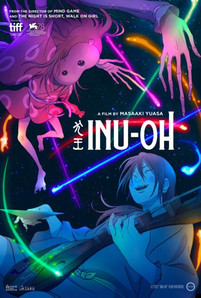Review
by Kim Morrissy,INU-OH
| Synopsis: |  |
||
Masaaki Yuasa (Director), Akiko Nogi (Screeplay), Taiyo Matsumoto (Original Character Design), and Yoshihide Otomo (Music) collaborate on this musical animation that tells the story of "Inu-oh," an unknown pop star of the Muromachi period. Based on the novel by Hideo Furukawa, this film depicts the friendship between Inu-oh and his buddy Tomona, a biwa player. |
|||
| Review: | |||
"Noh performers were the historical equivalent of rock stars" is the thought that sparked the genesis of this film, and boy does Masaaki Yuasa run with it here. More of an extended musical performance than a narrative film at times, INU-OH is a delightful audio and visual experience, made all the more memorable by its loving blend of two polar opposite styles. I really appreciate how INU-OH is such a thoughtful engagement with Japanese history. The film is initially thorough in its depiction of the Muromachi period, complete with atmospheric biwa instrumentation and Buddhist chants, but it introduces its magical realist elements early, making clear from the start that it's not concerned with strict accuracy. Rather, it's about engaging with society during a time when history is in the making. What events will be erased from history, and what will be marked in the records as the official truth? By structuring its narrative around those tensions, INU-OH lends itself the freedom to explore some rather absurd hypotheticals without entirely breaking the viewer's immersion. The relationship between art and politics lies at the heart of INU-OH. Historically, artists were required to bend over backwards to appease the Shogun's tastes, and it was of the utmost importance to be affiliated with a favored group. A common refrain throughout the film is the pressure to retread established conventions instead of creating new songs and routines. When Inu-Oh and Tomona's music becomes politically contentious, it's not necessarily because of the messaging in their lyrics at first, but because of how their innovations gave them overwhelming populist appeal. "Art is political" is an oft-repeated phrase in the modern day, but INU-OH gets to the heart of what that means: No matter what form it takes, art is a way of expressing one's place in the world. That might seem like a simple and rather obvious message, but the characters give them a profound significance in context. Tomona becomes blind in one of the opening scenes of the film, but his condition does nothing to diminish his zest for life, and he quickly comes to see music as his form of self-expression. Meanwhile, the eponymous Inu-Oh has a love of dancing, but his disfigured body is feared by all who can see him. The two make a likable pair as marginalized people who affirm and uplift each other. Even when they try to suppress parts of themselves by taking on a homogenized name or wearing a mask, their individuality still shines through in their performances, and it's easy to see why their audience loves their work. It's a story that's well-suited to Yuasa's off-beat style of visual presentation. Inu-Oh's limbs stretch ludicrously long, almost like he ate the Gum-Gum Fruit, while rock instruments and modern concert apparatuses spontaneously appear when they're relevant. It's that very unpredictability of the animations that make the performance scenes so enthralling, even when they go on for quite a bit longer than one would think is necessary for moving the story along. At the same time, I can't help but admire the confidence it takes to bend the rules of storytelling to such a degree. In a particularly inspired screenwriting move, the film doesn't even explain the reasoning behind the abrupt musical shift until well after the fact. INU-OH might very well be Yuasa's final project with Science SARU. That's a bittersweet thought to me, but if this is how it ends, I'm content. An absurdist anime that never forgets its heart, INU-OH stands shoulder-to-shoulder with Yuasa's best work. |
| Grade: | |||
|
Overall : B+
Story : B+
Animation : A
Art : A
Music : A
+ Engages thoughtfully with Japanese history, has strong thematic justification for its stylistic liberties |
|||
| discuss this in the forum (5 posts) | | |||
| Production Info: | ||
|
Full encyclopedia details about |
||